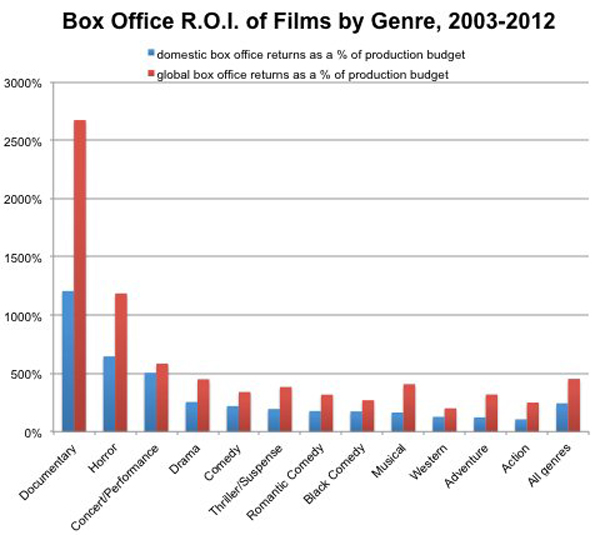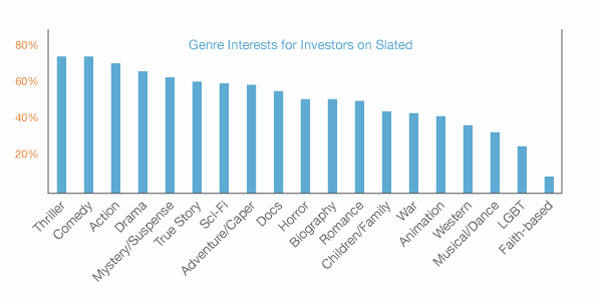By Colin Brown
We don’t really know how many feature films will end up being made this year – 50,000 seems to be the best global guess – but what we do know is that their genetic make-up will differ in every instance. “Each film has its own DNA,” observed WME agent Mark Ankner, speaking at a recent panel on film packaging organized by Pepperdine University as part of its certification program for film & TV finance. “No two films are alike,” echoed UTA agent Hailey Wierengo, sitting alongside him. “Each has its own unique set of hurdles.”
What we also know from DNA science is that even something as complex as the human genome – the sum total of all our hereditary information – boils down to four essential building blocks arranged and packaged in a myriad ways. By mapping those arrangements, we can not only pinpoint the individual signatures of our species in all its glorious variation, but also establish some common characteristics that help in making useful working assumptions.

And so it is with cinema: academics may argue all they like about the problems that come with labeling films according to shared storytelling elements and milieus, but genre classification is as good a starting point as any right now for determining a project’s prospects. If that project happens to be a mix-and-match of different genres, as so many are these days, then the commercial realities that come with such hybrids need to be acknowledged too.
At their most forensic, some of those commercial realities can make for uncomfortable reading. In a recent New York Times article, former statistics professor Vincent Bruzzese described how his combination of data analysis and focus groups has led to some of the following blunt conclusions: a cursed superhero never sells as well as a guardian superhero; bowling scenes tend to pop up in films that fizzle. Bruzzese, who spearheads the Worldwide Motion Picture Group, also makes this bold assertion: “Demons in horror movies can target people or be summoned. If it’s a targeting demon, you are likely to have much higher opening-weekend sales than if it’s summoned. So get rid of that Ouija Board scene.”
Purists will complain that breaking screenplays down this way is the very enemy of creativity. They will argue that cinema, like any artistic endeavor, should not slavishly mimic yesterday’s formulae based simply on what might have worked before. It should all start with the strength of the underlying material and the affecting nature of a story – one that ideally tells something new and surprising. This is all very true, but even outlaws have rules. No matter how killer the script, tough appraisals still need to be done about its likely audience, both at home and aboard. Different regions of the planet have different proclivities – as any territorial analysis of globally released blockbusters will soon tell you – and different genres come with their own industrial expectations, based on how similar sets of films have performed in the past, particularly at the box office. As a producer, it pays to do all that necessary homework in order to maximize your project’s chance of being made on your chosen terms.
It is only once you have an honest handle on a story’s core appeal that realistic numbers can start being attached along with any additional elements needed to prime that project for greenlight status. As CAA’s Micah Green affirmed in a Variety article about independent film financing: “It is critical to assess the global market’s appetite for a package in advance of budgeting and shopping to financiers. Presenting an unrealistic package or budget can kill a project’s momentum.”


With all this in mind, filmonomics begins this five-part examination of film packaging with a quick look at how different genres are evaluated in the eyes of industry gatekeepers and tastemakers. Guiding us through that process is Susan Wrubel, the international film consultant who also oversees Slated’s relationships with U.S. distributors, packaging agents, producers, financiers and foreign sales companies.
Just to be clear: such assessments of each genre are not intended as definitive check-lists, but rather as a current snapshot of what film professionals and seasoned investors think when weighing up different types of stories, outside the studio system. Their analysis will have been developed over years of pitch meetings, consultation meetings and project evaluations. For them, each genre comes with its own shifting calculus based on market conditions. Those prisms are then filtered again through their own business mandates and objectives.
The net result of this triangulation process is that while every genre comes with its own distinct sequencing code, none of it is DNA absolute. Because of the constant trade-offs involved, what you read below works better as a mirror than as a map. One side of the negotiating table should be asking these questions in order to start sizing up a project; the other should come prepared to answer them. Think of it as generic engineering – the intertwining foundations that inform the rest of the packaging process.
DRAMA
Think: script, director, producer, cast, budget level

“Dramas need to have strong packages if they are going to travel (i.e. sell in the international market) and/or break out. Budgets need to be carefully examined as films in this genre are going to be more execution dependent. Sundance, Telluride and the bigger international festivals are great launch pads for dramatic features at all levels and often films that may be perceived as being smaller really resonate with festival audiences thus creating buzz.”
- The script needs to be strong.
- If the director is not experienced, s/he should have some track record such as a strong short film, video work or something else that proves execution ability.
- Can this director attract talent? If not, does it matter for the story?
- Is there a strong producer who can help a new filmmaker?
- Is the budget level commensurate with the cast wish list?
- Is this something that should play major festivals in order to galvanize attention?
ACTION / THRILLER
Think: budget level, stars, concept

“Stars are usually the driving force with bigger action or thriller-based genre films. The director is not as important since this genre is more about concept and actors. However, the director should still make sense for the budget, i.e. no first timers on a $30 million film – unless there is studio behind it, in which case that is a different analysis.”
- Ancillary value is good on action, and sales agents will usually look at these to assess the film.
- With the right cast, the project should ‘travel’ and can always be sold together with other films by a sales company.
- Is the budget realistic and will the material (script) attract a certain level of actor?
- Producers, stunts & visual effects teams are crucial.
- Indie action films like ONG BOK or THE RAID became international sensations due to their fast-paced, choreographed fight-scenes that “broke the mold” at international markets, and these are great examples of low budget action that worked.
HORROR / SUSPENSE
Think: script, budget, director

“The cast not necessarily as important on a horror film and budgets tend be lower. But it has to be director-driven and well executed.”
- Script needs to be tight and make sense.
- Is it scary/high-concept?
- Ancillary value is usually good on horror and it can travel.
- Again, if the director is not proven, there should be a strong experienced producer to help shepherd the project.
- Is this one that can make festival midnight sections? Is it one to promote at Comic-Con?
- Can you build audience through actors with massive followings?
COMEDY
Think: script, director, actors

“The budget really needs to be commensurate with cast, and unless there are mega-stars involved then the likelihood is that this may not be something that will pre-sell abroad. Individual countries have very different sensibilities as to comedy.”
- The concept should be strong.
- Can the director attract meaningful actors?
- Will this comedy translate abroad?
- Wedding-themed films tend to be strong sells.
DOCUMENTARY
Think: subject matter, director/producing/editing team

“The norm for documentary budgets is usually $1 million or less. Above that, what is attained for the budget level?”
- Access to footage or subject.
- Can the director tell a story that is more than talking heads?
- Is the subject matter topical and engaging?
- Is there a core audience and a way to access them?
- What is the ultimate goal for the film: theatrical perhaps, or just VOD and TV?
FAMILY
Think: concept, execution, team in place

“Who is the audience exactly and is there a marketing plan that discusses how to reach them?”
- Will the film have theatrical appeal or is it something more for DVD/VOD/TV?
- Is there franchise potential or underlying familiar material that makes this more relevant?
- Is the story universal enough that it can work domestically and internationally?
SCI-FI / FANTASY
Think: concept, team in place

“This is usually a genre that excites foreign sales companies, as long as they can believe in the concept, pitch and execution.”
- The visual effects partner involved is key and will also dictate the budget somewhat.
- Is this high-concept enough to be a broad film?
- Has the director done sci-fi before?
- Is the film cast dependent? And if so, can the director attract necessary actors?
- Can it be made for a price (i.e. a controlled budget)?
ROMANCE
Think: director and star-driven

“Who specifically is the audience: is this a teen story, an adult story or something that speaks to multi-generations?”
- Is this sweeping and broad, or small and intimate?
- Will the romance translate internationally and, if so, who are the actors and can they travel?
- How sexy/racy is it?
- Can the director execute and attract necessary talent?
- Is budget commensurate with cast?
- Is this based on pre-existing material?
FAITH-BASED
Think: subject matter, core audience, ancillary value

“The cast is not usually as key in faith-based films. However, with a great name, the film could have cross-over potential (i.e. the film could appeal to audiences that enjoy other genres too) depending on subject-matter and execution.”
- Is there a comprehensive grass-roots plan to reach the core audience
- Director not as important: s/he just needs to be competent and tell a good story.
- Budgets should be modest, particularly where there are no star names attached.
- Does the story have international appeal?
ANIMATION
Think: audience, team, animation-style

“Depending on the subject matter, animation can travel. But, again, indie animation is a tough proposition due to the high costs associated with the genre. Does the film have the chance to walk into a studio?”
- Where is the animation being done and what experience do the animators have?
- Is there a certain look or style to the animation?
- Is there studio involvement?
- Is there underlying material that makes this project relevant?
- Is there franchise potential?
MUSICAL
Think: concept, subject matter, audience, music rights

“The budget should be commensurate with the breadth and scope of the film. It is key that there is a realistic number in the budget for clearances if the music is not original. If the music is original, what is the hook to get people in to see the film? Or will it be a festival darling just like ONCE?”
- Is the music known and pre-existing?
- If so, are all clearances in place?
- Who is this targeted towards?
- Is there an international audience for the music?
- What level of talent will be attached: singers only or actors who sing?
- Will this be kids and adults?
- Soundtrack potential?
WESTERN
Think: director, cast, execution

“If executed properly, hewing to the genre’s traditions, Westerns can still attract attention. They remain a challenge abroad. However, with a highly rated director, some great acting choices, and not to mention a great story, these might travel.”
- The story should be classic and yet unique. Since Westerns follow a certain format and tend to be larger in scope; indie Westerns tend to be tougher sells.
- Will the film appeal to festivals that can help create buzz?
- Is this a director who is comfortable in the genre and who can attract a meaningful cast?
In next week’s installment on film packaging, filmonomics will look at the key considerations that surround the budgeting of independent film projects, followed by installments on assessing films by cast, directors, producers, and financing structures.





